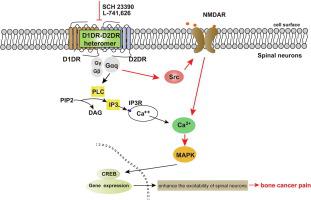Journal of Advanced Research ( IF 11.4 ) Pub Date : 2020-08-13 , DOI: 10.1016/j.jare.2020.08.005 Wen-Ling Dai 1 , Yi-Ni Bao 1 , Ji-Fa Fan 1 , Bin Ma 1 , Shan-Shan Li 1 , Wan-Li Zhao 1 , Bo-Yang Yu 1, 2 , Ji-Hua Liu 1, 2

|
Introduction
Spinal N-methyl-D-aspartate receptor (NMDAR) is vital in chronic pain, while NMDAR antagonists have severe side effects. NMDAR has been reported to be controlled by G protein coupled receptors (GPCRs), which might present new therapeutic targets to attenuate chronic pain. Dopamine receptors which belong to GPCRs have been reported could modulate the NMDA-mediated currents, while their exact effects on NMDAR in chronic bone cancer pain have not been elucidated.
Objectives
This study was aim to explore the effects and mechanisms of dopamine D1 receptor (D1DR) and D2 receptor (D2DR) on NMDAR in chronic bone cancer pain.
Methods
A model for bone cancer pain was established using intra-tibia bone cavity tumor cell implantation (TCI) of Walker 256 in rats. The nociception was assessed by Von Frey assay. A range of techniques including the fluorescent imaging plate reader, western blotting, and immunofluorescence were used to detect cell signaling pathways. Primary cultures of spinal neurons were used for in vitro evaluation.
Results
Both D1DR and D2DR antagonists decreased NMDA-induced upregulation of Ca2+ oscillations in primary culture spinal neurons. Additionally, D1DR/D2DR antagonists inhibited spinal Calcitonin Gene-Related Peptide (CGRP) and c-Fos expression and alleviated bone cancer pain induced by TCI which could both be reversed by NMDA. And D1DR/D2DR antagonists decreased p-NR1, p-NR2B, and Gαq protein, p-Src expression. Both Gαq protein and Src inhibitors attenuated TCI-induced bone cancer pain, which also be reversed by NMDA. The Gαq protein inhibitor decreased p-Src expression. In addition, D1DR/D2DR antagonists, Src, and Gαq inhibitors inhibited spinal mitogen-activated protein kinase (MAPK) expression in TCI rats, which could be reversed by NMDA.
Conclusions
Spinal D1DR/D2DR inhibition eliminated NMDAR-mediated spinal neuron activation through Src kinase in a Gαq-protein-dependent manner to attenuate TCI-induced bone cancer pain, which might present a new therapeutic strategy for bone cancer pain.
中文翻译:

阻断脊髓多巴胺 D1/D2 受体通过 Gαq 和 Src 激酶抑制 NMDA 受体的激活以减轻慢性骨癌疼痛
介绍
脊髓 N-甲基-D-天冬氨酸受体 (NMDAR) 在慢性疼痛中至关重要,而 NMDAR 拮抗剂具有严重的副作用。据报道,NMDAR 受 G 蛋白偶联受体 (GPCR) 控制,这可能会提供新的治疗靶点来减轻慢性疼痛。据报道,属于 GPCR 的多巴胺受体可以调节 NMDA 介导的电流,而它们对慢性骨癌疼痛中 NMDAR 的确切影响尚未阐明。
目标
本研究旨在探讨多巴胺D1受体(D1DR)和D2受体(D2DR)对慢性骨癌痛NMDAR的影响及机制。
方法
使用Walker 256 大鼠胫骨内骨腔肿瘤细胞植入(TCI)建立骨癌疼痛模型。通过 Von Frey 试验评估伤害感受。包括荧光成像板读数器、蛋白质印迹和免疫荧光在内的一系列技术被用于检测细胞信号通路。脊髓神经元的原代培养物用于体外评估。
结果
D1DR 和 D2DR 拮抗剂均降低了 NMDA 诱导的原代培养脊髓神经元中 Ca 2+振荡的上调。此外,D1DR/D2DR 拮抗剂可抑制脊髓降钙素基因相关肽 (CGRP) 和 c-Fos 表达,并减轻 TCI 诱导的骨癌疼痛,而 NMDA 均可逆转这种疼痛。并且 D1DR/D2DR 拮抗剂降低了 p-NR1、p-NR2B 和 Gαq 蛋白、p-Src 的表达。Gαq 蛋白和 Src 抑制剂都减轻了 TCI 诱导的骨癌疼痛,这也被 NMDA 逆转。Gαq 蛋白抑制剂降低了 p-Src 的表达。此外,D1DR/D2DR 拮抗剂、Src 和 Gαq 抑制剂可抑制 TCI 大鼠脊髓丝裂原活化蛋白激酶 (MAPK) 的表达,这可被 NMDA 逆转。
结论
脊髓 D1DR/D2DR 抑制通过 Src 激酶以 Gαq 蛋白依赖性方式消除 NMDAR 介导的脊髓神经元激活,从而减轻 TCI 诱导的骨癌疼痛,这可能为骨癌疼痛提供一种新的治疗策略。











































 京公网安备 11010802027423号
京公网安备 11010802027423号